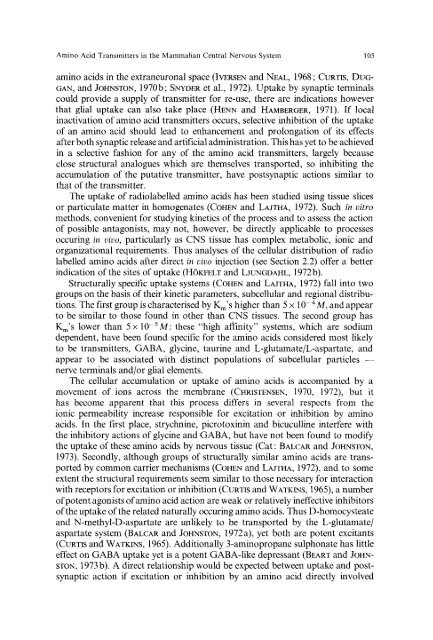Amino acid transmitters in the mammalian central nervous system
Amino acid transmitters in the mammalian central nervous system
Amino acid transmitters in the mammalian central nervous system
Create successful ePaper yourself
Turn your PDF publications into a flip-book with our unique Google optimized e-Paper software.
<strong>Am<strong>in</strong>o</strong> Acid Transmitters <strong>in</strong> <strong>the</strong> Mammalian Central Nervous System 105<br />
am<strong>in</strong>o <strong>acid</strong>s <strong>in</strong> <strong>the</strong> extraneuronal space (IVERSEN and NEAL, 1968; CURTIS, DUG-<br />
GAY, and JOHNSTON, 1970b; SNYDER et al., 1972). Uptake by synaptic term<strong>in</strong>als<br />
could provide a supply of transmitter for re-use, <strong>the</strong>re are <strong>in</strong>dications however<br />
that glial uptake can also take place (HENN and HAMBERGER, 1971). If local<br />
<strong>in</strong>activation of am<strong>in</strong>o <strong>acid</strong> <strong>transmitters</strong> occurs, selective <strong>in</strong>hibition of <strong>the</strong> uptake<br />
of an am<strong>in</strong>o <strong>acid</strong> should lead to enhancement and prolongation of its effects<br />
after both synaptic release and artificial adm<strong>in</strong>istration. This has yet to be achieved<br />
<strong>in</strong> a selective fashion for any of <strong>the</strong> am<strong>in</strong>o <strong>acid</strong> <strong>transmitters</strong>, largely because<br />
close structural analogues which are <strong>the</strong>mselves transported, so <strong>in</strong>hibit<strong>in</strong>g <strong>the</strong><br />
accumulation of <strong>the</strong> putative transmitter, have postsynaptic actions similar to<br />
that of <strong>the</strong> transmitter.<br />
The uptake of radiolabelled am<strong>in</strong>o <strong>acid</strong>s has been studied us<strong>in</strong>g tissue slices<br />
or particulate matter <strong>in</strong> homogenates (COHEN and LAJTHA, 1972). Such <strong>in</strong> vitro<br />
methods, convenient for study<strong>in</strong>g k<strong>in</strong>etics of <strong>the</strong> process and to assess <strong>the</strong> action<br />
of possible antagonists, maynot, however, be directly applicable to processes<br />
occur<strong>in</strong>g <strong>in</strong> vivo, particularly as CNS tissue has complex metabolic, ionic and<br />
organizational requirements. Thus analyses of <strong>the</strong> cellular distribution of radio<br />
labelled am<strong>in</strong>o <strong>acid</strong>s after direct <strong>in</strong> vivo <strong>in</strong>jection (see Section 2.2) offer a better<br />
<strong>in</strong>dication of <strong>the</strong> sites of uptake (HOKFELT and LJUNGDAHL, 1972b).<br />
Structurally specific uptake <strong>system</strong>s (COHEN and LAJTHA, 1972) fall <strong>in</strong>to two<br />
groups on <strong>the</strong> basis of <strong>the</strong>ir k<strong>in</strong>etic parameters, subcellular and regional distributions.<br />
The first group is characterised by Km's higher than 5 x 10- 4M, and appear<br />
to be similar to those found <strong>in</strong> o<strong>the</strong>r than CNS tissues. The second group has<br />
Km'S lower than 5x 10-SM: <strong>the</strong>se "high at'f<strong>in</strong>ity" <strong>system</strong>s, which are sodium<br />
dependent, have been found specific for <strong>the</strong> am<strong>in</strong>o <strong>acid</strong>s considered most likely<br />
to be <strong>transmitters</strong>, GABA, glyc<strong>in</strong>e, taur<strong>in</strong>e and L-glutamate/L-aspartate, and<br />
appear to be associated with dist<strong>in</strong>ct populations of subcellular particles --<br />
nerve term<strong>in</strong>als and/or glial elements.<br />
The cellular accumulation or uptake of am<strong>in</strong>o <strong>acid</strong>s is accompanied by a<br />
movement of ions across <strong>the</strong> membrane (CHRISTENSEN, 1970, 1972), but it<br />
has become apparent that this process differs <strong>in</strong> several respects from <strong>the</strong><br />
ionic permeability <strong>in</strong>crease responsible for excitation or <strong>in</strong>hibition by am<strong>in</strong>o<br />
<strong>acid</strong>s. In <strong>the</strong> first place, strychn<strong>in</strong>e, picrotox<strong>in</strong><strong>in</strong> and bicucull<strong>in</strong>e <strong>in</strong>terfere with<br />
<strong>the</strong> <strong>in</strong>hibitory actions of glyc<strong>in</strong>e and GABA, but have not been found to modify<br />
<strong>the</strong> uptake of <strong>the</strong>se am<strong>in</strong>o <strong>acid</strong>s by <strong>nervous</strong> tissue (Cat: BALCAR and JOI~NSTON,<br />
1973). Secondly, although groups of structurally similar am<strong>in</strong>o <strong>acid</strong>s are transported<br />
by common carrier mechanisms (COHEN and LAJTHA, 1972), and to some<br />
extent <strong>the</strong> structural requirements seem similar to those necessary for <strong>in</strong>teraction<br />
with receptors for excitation or <strong>in</strong>hibition (CURTIS and WATK~S, 1965), a number<br />
of potent agonists of am<strong>in</strong>o <strong>acid</strong> action are weak or relatively <strong>in</strong>effective <strong>in</strong>hibitors<br />
of <strong>the</strong> uptake of <strong>the</strong> related naturally occur<strong>in</strong>g am<strong>in</strong>o <strong>acid</strong>s. Thus D-homocysteate<br />
and N-methyl-D-aspartate are unlikely to be transported by <strong>the</strong> L-glutamate/<br />
aspartate <strong>system</strong> (BALCAR and JOHNSTON, 1972a), yet both are potent excitants<br />
(CURTIS and WATKINS, 1965). Additionally 3-am<strong>in</strong>opropane sulphonate has little<br />
effect on GABA uptake yet is a potent GABA-Iike depressant (BEART and JOHN-<br />
STON, 1973 b). A direct relationship would be expected between uptake and postsynaptic<br />
action if excitation or <strong>in</strong>hibition by an am<strong>in</strong>o <strong>acid</strong> directly <strong>in</strong>volved













